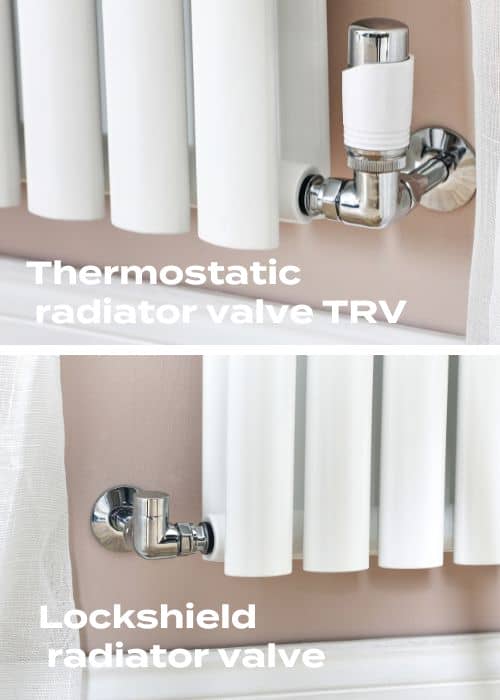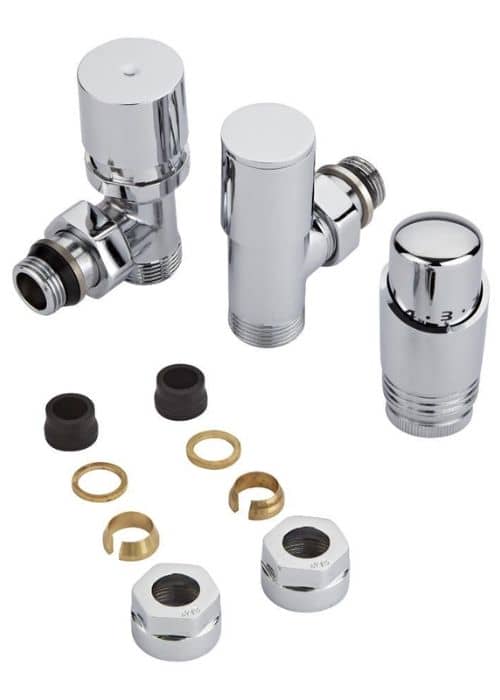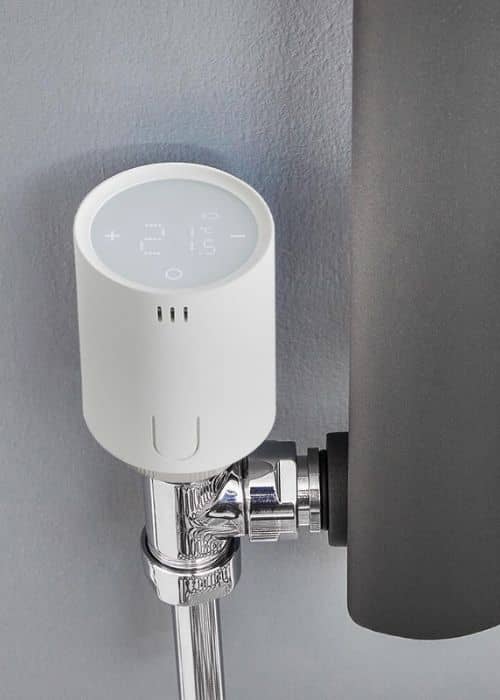Radiator valves come in all shapes and sizes. You now have a huge choice between thermostatic or manual, vintage-style or modern, angled or straight.
You can even go for smart radiator valves to create a WiFi connected heating system.
It’s a lot to take in, we get it.
This is why one of the questions we often get asked is, are radiator valves universal? In this guide, we will answer this common heating FAQ and help you find the best valves for your radiators.
Contents
ToggleWhat do radiator valves do?
Radiator valves control the radiator’s heat output by adjusting the flow of hot water from the boiler to the radiator. Most radiators have a thermostatic radiator valve (TRV) on one side, and a lockshield valve on the other.
Thermostatic valves usually have a large head with numbers 0 – 5 which you can twist to adjust the air temperature. TRVs are a great, energy-saving tool to control the temperature in the room.
However, they should not be used on the radiator in the same space as the wall-mounted room thermostat as this can create a conflict in keeping the room the temperature you want.
The lockshield is a smaller valve with a protective cap covering a metal spindle which can only be turned with pliers.
You can also go for manual radiator valves which work in the same way as an on/off basin tap. But, most homes prefer to use thermostatic valves as they can also help save money on energy bills.

Are all radiator valves standard size?
The simple answer is, yes. The standard radiator valve size is 15mm. All of our radiator valves feature standard 15mm compression fittings.
This is because most copper pipes in UK homes are 15mm in modern central heating systems. This is the measurement of the outside diameter of the pipe in millimeters.
If you have an older heating system, the width of the pipes may be smaller such as 8mm or 10mm. These are known as microbore pipes.
You may also find 22mm or 28mm pipes in your home, particularly in the bathroom. This is to account for the increased water flow required from the hot water tank to reach the bath, toilet etc.
If that is the case and you would like to update your radiator valves, make sure to look for a pair of valves with copper adapters included. This will enable the valve to connect to the pipe perfectly by adapting the width of the pipe to fit the standard 15mm inlet.

How do I know what size valves I have?
If you are unsure what the size of your current valves are, the easiest thing to do is measure the diameter of the pipe where the valve connects to the existing radiator.
To do this you will need to turn the heating off, turn the valves off, drain the radiator, then disconnect one of the valves to access the pipe and take the measurement.
For more information head over to our how to change a radiator valve guide.
Do radiator valves fit all radiators?
Yes, radiator valves fit all radiators in modern heating systems. This is because the size of the connection between the valve and the radiator is universal.
Our radiator valve collection features standard ½” threads on each valve so that they are designed to fit all radiators.
Are radiator valves interchangeable?
As we have mentioned, radiator valves are universal and have a standard 15mm size connection from the valve to the pipe in modern heating systems. This means that most of the time they are interchangeable.
However, it also depends on where the radiator inlets are and the position of the pipework. To help explain this a little easier, let’s look at the different types of valves there are.
Types of radiator valves:
Angled and corner valves are interchangeable. They can be used with radiators that have side or bottom inlets and pipes that come out from the wall or up from the floor.
However, if you currently have angled or corner valves, you can’t swap them for H-block valves. This is because they are are designed for radiators with middle connection inlets.
The same can be said for straight valves since they are only suitable for bottom inlets where the pipework comes up from the floor.
Are thermostatic radiator valve heads interchangeable?
If you find that your thermostatic radiator valve head is broken or damaged but the remaining parts of the valves have no issues, you should be able to only replace the valve head.
Thermostatic radiator valve heads are interchangeable and can be purchased separately from some DIY stores.
Just make sure to measure the connection on your current TRV head to make sure that your replacement will slot in perfectly when fitting the TRV.
Are smart radiator valves universal?
Smart radiator thermostats are a great way to create an efficient heating system, control your room temperature easily and reduce your energy usage and cost.
The good news is, our smart radiator valves are universal.
The Milano Connect smart radiator thermostat is designed to replace standard size thermostatic heads to turn your existing valve into a Wi-Fi connected system.
You can even control the smart valve via Google Home and Amazon Alexa. For more info head over to our how to install Milano Connect smart radiator thermostats guide.
Need new radiator valves?
We hope this guide has helped you understand more about radiator valves and how some of them are interchangeable. If you are looking for new radiator valves, make sure to check out our stylish and extensive radiator valve collection. Or, if you are still unsure which valves you need for your radiator or towel rail, head over to our radiator valve guide.
Frequently Asked Questions
Radiator valves incorporate a 15mm connection as standard from the valve to pipe in modern heating systems and designer radiators. As such, they are interchangeable in most cases.
That said, the positioning of the radiator inlets and pipework can influence whether or not they can be swapped over without issue. Basically, angled and corner valves can be interchanged easily, but these types can’t be discarded for H-block valves that require a middle connection inlet. Similarly, straight valves are only suitable for connection with radiators with bottom inlets.
For further insight, browse our blog, Are radiator valves universal?
The purpose of radiator valves is to control the heat output of radiators by altering the flow of hot water from the boiler to the radiator. The majority of modern radiators feature a thermostatic radiator valve, or TRV, on one side, and a lockshield valve on the opposite side.
Their use can be negated in rooms in which thermostats are present, as it could create a conflict in achieving the temperature you desire. Typically, TRVs will be more popular than manual valves, as their automatic settings can help with long-term energy savings.
For a deeper insight, explore our blog, Are radiator valves universal?
Straight and angled radiator valves both boast an appearance that lives up to their moniker.
Straight radiator valves don’t incorporate any curves or bends, instead connecting to a bathroom radiator or standard designer radiator up from the floor.
Angled valves are usually used to provide a clean finish, concealing pipework and plumbing more effectively than their straight counterparts.
For further information about all types of radiator valves, explore our full Radiator Valve Guide.
Radiator valves perform the function of controlling temperature, and they feature in pairs on radiators.
One valve, commonly referred to as the control valve, is used to turn the radiator on and off. It can also mediate the amount of water entering the radiator to influence temperature.
The other valve is the lockshield valve, which is used in the balancing of radiators within a heating system.
For a more detailed insight into radiator valves on the whole, explore our Radiator Valve Guide.
Jess has a passion for interior design and wants to inspire people to look at radiators as home decor. She enjoys keeping on top of the latest design and heating trends to ensure the Advice Centre has all the information and inspiration homeowners need to make the best choice for them.





